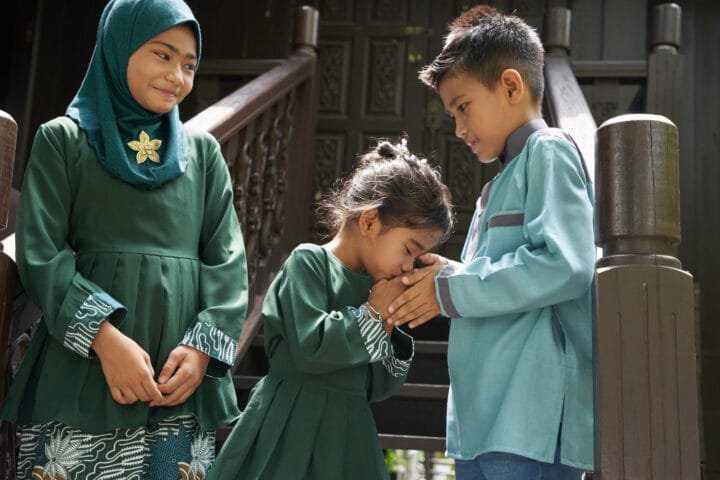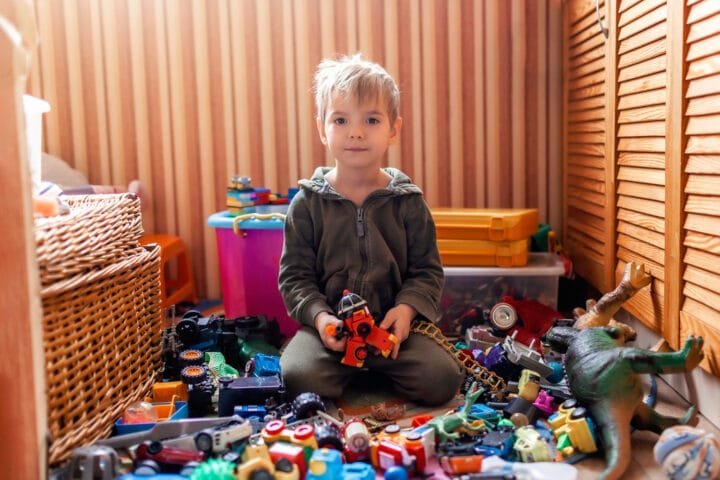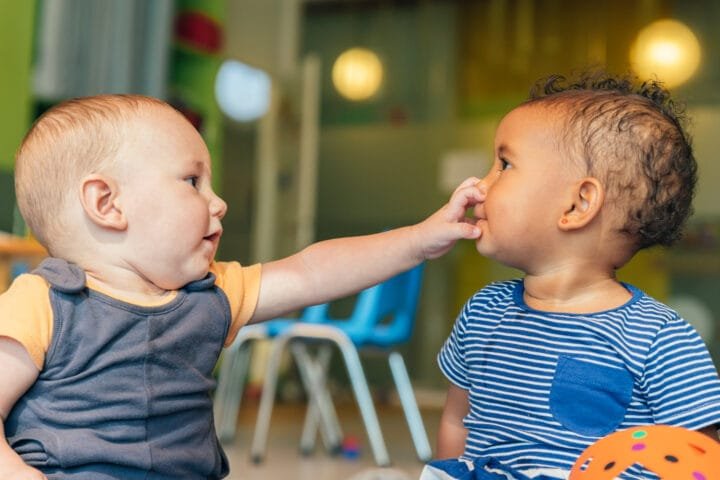Raising Global Citizens: A Fun & Easy Guide to Teaching Kids About Religions
Imagine a world where our children understand different religions and embrace our global community’s diverse tapestry of beliefs. In an era where interconnectedness is the norm, it is no longer a luxury but a necessity to foster religious literacy in our children. This guide, specifically designed for parents, focuses on teaching kids about world religions in a practical and engaging way.
What are Religions? (World Religions for Kids)
It can be challenging to explain religion to a young child. Their curious minds are filled with “why” questions, and faith is an abstract concept that can be difficult to grasp. It’s true… there is an invisible person in the sky… who talks to people… and there are magical books…” We’ve all been there.
The Big Idea: Faith and Belief Systems for Kids
Let’s start with a simple foundation rather than getting entangled in a maze of theological complexities. Religion is a set of ideas about the world, a moral compass that guides our lives. Religion is finding meaning and purpose by connecting with something larger than ourselves.
Why Do People Have Different Religions? (Kids and Religion)
“Why are there so many different religions, Mommy?” People have diverse tastes in music, food, and clothing. Still, they also have different ways of understanding the world and connecting with God.
Religions, like vibrant threads in a rich tapestry of human knowledge, have flourished across the globe, each influenced by history, culture, and unique experiences. This diversity is not a source of confusion but a beautiful expression of humanity, inspiring us to appreciate the unique beauty of each thread.
Common Threads: Understanding Different Religions
On the surface, religions may appear vastly different, like a kaleidoscope of colours and patterns. Still, they often share common threads of kindness, compassion, and community. While each flower is unique in its beauty, they all need sunlight and water to thrive in the garden.
Exploring Major World Religions (Religious Education for Children)
Take an exciting journey around the globe to learn about religions. Don’t worry; we won’t get bogged down in complex doctrines and theological arguments. Instead, we will focus on the key figures, captivating stories, and unique practices that make each religion unique.
Christianity
Core Beliefs: The Christian faith believes that one true God created the universe and sent his son, Jesus Christ, as a beacon of love and forgiveness for humanity.
Key Figure: The image of Jesus Christ with open arms symbolizes his message of compassion and acceptance.
Practices: Attending church, praying, and participating in religious holidays like Christmas, with dazzling lights and cheerful melodies, and Easter, with colourful eggs and a message of hope.
Fun Fact: It is interesting to note that the Bible is the most translated book in the world, available in more than 700 languages!
Islam
Core Beliefs: Muslims believe that there is only one God, Allah, who guides and protects them and follows Muhammad’s teachings.
Key Figure: Muhammad inspired millions with his wisdom and compassion worldwide.
Practices: Praying five times a day, facing the holy city of Mecca; fasting during Ramadan, a time for reflection and spiritual growth; visiting a mosque, a place of serenity and community, with its soaring minarets and intricate calligraphy.
Fun Fact: The Quran, the holy book of Islam, is believed to be the literal word of God, revealed to Prophet Muhammad over 23 years ago. It’s recited in Arabic, its original language, by Muslims worldwide.
Judaism
Core Beliefs: Jewish people believe in one God and follow the Torah, a sacred scroll containing the first five books of the Hebrew Bible.
Key Figure: Moses who led the Israelites out of slavery in Egypt and received the Ten Commandments from God on Mount Sinai.
Practices: Celebrating holidays like Hanukkah, the festival of lights, with its spinning dreidels and delicious latkes; Passover, commemorating the Exodus from Egypt with a special Seder meal; attending synagogue services; following dietary laws (kosher).
Fun Fact: The Torah is handwritten on a scroll and kept on a special ark in the synagogue. It’s treated with deep reverence and considered the most sacred object in Judaism.
Hinduism
Core Beliefs: Hindus believe in many gods and goddesses, each representing different divine aspects. They also believe in karma, the idea that our actions have consequences, and reincarnation, the cycle of birth, death, and rebirth.
Key Figures: Brahma, the creator; Vishnu, the preserver; Shiva, the destroyer; and a pantheon of other gods and goddesses, each with unique stories and powers.
Practices: Yoga, a practice that unites the mind, body, and spirit through physical postures, breathing exercises, and meditation; celebrating vibrant festivals like Diwali, the festival of lights, and Holi, the festival of colours, where people joyously throw coloured powder and water at each other.
Fun Fact: Hinduism is one of the oldest religions in the world, with roots dating back 4,000 years! It’s a rich and diverse tradition with many beliefs and practices.
Buddhism
Core Beliefs: Buddhists follow the teachings of the Buddha, who taught that the root of all suffering is attachment and that we can achieve enlightenment by following the Eightfold Path, a path of wisdom, ethical conduct, and mental discipline.
Key Figure: The Buddha (Siddhartha Gautama), a prince who renounced his luxurious life to seek enlightenment and teach others how to find lasting peace and happiness.
Meditation is a practice that cultivates mindfulness and inner peace, living a life of compassion and non-violence and visiting temples and serene places of worship adorned with Buddha statues and colourful prayer flags.
Fun Fact: Buddhism originated in India but has spread worldwide, adapting to different cultures and giving rise to diverse traditions and practices.

III. Respecting Different Beliefs (Teaching Tolerance to Children)
Having explored world religions in a whirlwind, let us discuss respect, a vital concept. It is essential to teach our children that respecting other people’s beliefs, no matter how different they may be, is just as crucial as making fun of our favourite hobby or unique quirk.
The Golden Rule
The timeless wisdom is, “Treat others as you want to be treated.” It’s a universal principle fostering harmony and understanding that transcends cultures and religions. Let’s encourage our children to apply this principle to all their interactions, regardless of others’ backgrounds or beliefs.
Celebrating Diversity (Diversity and Inclusion for Children)
The world would be dull and monotonous if everyone looked, thought, and acted alike. Diversity is the spice of life, the vibrant tapestry that makes our world a fascinating place to live. Let’s teach our children to appreciate our global community’s diversity of cultures, traditions, and beliefs.
Avoiding Stereotypes
As we would not want to be judged for a single characteristic, we must teach our children not to make assumptions about people based on their religion. We should encourage our children to look beyond labels and know people for who they are. This is not just based on their outward appearance or one characteristic. Everyone has an individual universe full of feelings, thoughts, and experiences.

Learning from Each Other (Interfaith Education for Children)
The most effective way to learn about different religions is to interact with people, listen to their stories, and broaden our horizons.
Sharing Stories and Experiences
Invite your friends, neighbours, or colleagues of a different religion to a meal or casual get-together! Sharing stories and experiences breaks down barriers and fosters understanding.
Visiting Places of Worship
Visit the local church, mosque, synagogue, or temple as a family adventure (remember to call in advance). Children can gain knowledge and insight by seeing a religious service up close and personal.
Engaging with Religious Texts and Art
Children can be inspired and deepen their understanding of many religions. Explore religious art from different cultures by reading age-appropriate stories from the Bible, Quran, Torah, or other religious texts. Visit museums or art galleries.

Growing Together (Global Citizenship Education)
Introducing our children to different religions is a journey that evolves as they grow and learn. Let’s encourage open communication, nurture their curiosity, and help them become responsible, compassionate global citizens.
Open Communication
Children should feel comfortable asking questions, expressing their doubts, and sharing their feelings about religion in an atmosphere of open communication. Encourage respectful dialogue with an open heart.
Building Understanding Bridges
Emphasize the importance of empathy and compassion in our interactions with others. We can use stories, role-playing, and real-life examples to nurture their empathy. We can encourage them to step into another person’s shoes and consider the world from their perspective.
Celebrating Shared Humanity
We are all capable of love, acceptance, and belonging regardless of our beliefs and backgrounds. Let’s celebrate those shared values and work together to promote harmony and inclusion.
Addressing Tough Questions (How to Talk to Kids about Religious Conflict)
Religion is indeed a sensitive and complex topic. Our children may hear news stories or comments about religious conflict or intolerance. Addressing these questions honestly and age-appropriately is essential.
Like any group, there will always be people who misuse or misinterpret religious teachings to justify harmful actions. Nevertheless, it’s imperative to emphasize that these actions do not reflect religion’s true spirit.
Using these opportunities to teach children critical thinking and media literacy is also an option. Please encourage them to question what they hear and seek out diverse viewpoints.
Nurturing Spiritual Identity (Helping Children Develop Their Own Spiritual Identity)
Developing our children’s spiritual development is one of the most critical things we can do as parents. A supportive and open environment where children can cultivate their spirituality is essential. This is whether we raise them within a specific religious tradition or encourage them to explore other paths.
These things include attending religious services, participating in religious rituals, reading sacred texts, or simply conversing about the big questions in life. Our children should be allowed to explore and reflect, discovering their spiritual path.

Resources for Further Exploration (World Religions Curriculum)
Need help finding the right resources to teach your children about world religions? Don’t worry, you’re not alone. Here are some suggestions to get you started:
- Books: Your local library or bookstore is a goldmine of age-appropriate books about different religions. Look for books with engaging illustrations and captivating stories.
- Websites: Explore websites like National Geographic Kids, BBC Religions, and Khan Academy for interactive and informative content that captures your child’s interest.
- Museums: Many museums offer exhibits on world religions, providing immersive and interactive learning experiences that bring history and culture to life.
- Community Organizations: Connect with local interfaith organizations or religious communities to learn more about their beliefs and practices firsthand. Many communities offer open houses or events where you can meet members and ask questions.
Recommended Reads: Exploring the World of Religions with Children
Looking for captivating and informative books to guide your child’s exploration of world religions? Here are a few recommendations to spark their curiosity and foster understanding:
- The Kids Book of World Religions: This beautifully illustrated book offers a gentle introduction to the major religions of the world, exploring their core beliefs, key figures, and unique practices. Its engaging storytelling and vibrant visuals make it a perfect starting point for young explorers of faith.
- Who Believes What?: Exploring the World’s Major Religions: This book takes a simple and accessible approach to explaining different religions, answering common questions and highlighting shared values. Its colourful illustrations and easy-to-understand text make it an excellent choice for younger children.
- Celebrating Different Beliefs: This book celebrates the diversity of religious traditions around the world, showcasing the beauty and richness of each faith through stories, poems, and illustrations. It encourages children to appreciate the tapestry of beliefs that make up our global community.
- A Kid’s Guide to World Religions: This comprehensive guide delves deeper into the major religions of the world, covering their history, beliefs, practices, and influential figures. It’s an excellent resource for older children and teens seeking a more in-depth understanding of different faiths.
- What Do You Believe?: Big Questions About Religion: This thought-provoking book encourages children to grapple with the big questions about religion, exploring different perspectives and inviting them to reflect on their beliefs. It’s a valuable resource for fostering critical thinking and open-mindedness.
- Everyone Prays: Celebrating Faith Around the World: This beautifully illustrated book explores how people pray worldwide, highlighting the power of faith and spirituality. It introduces children to different prayer traditions and encourages them to appreciate the common threads that connect us all.
- The Religions Book: Big Ideas Explained: This visually engaging book offers a clear and concise overview of the major religions, exploring their key concepts and historical development. It’s a valuable resource for children and adults seeking a deeper understanding of the world’s faiths.
Beyond the Basics: Delving Deeper into Religious Concepts
Once your children understand different religions, you can explore more complex concepts, tailoring your approach to their age and maturity level.
- Sacred Texts: Introduce your children to holy texts of different religions, such as the Bible, the Quran, Torah, and the Bhagavad Gita. Read age-appropriate stories and discuss their values and teachings.
- Religious Symbols: Explore the symbolism behind religious icons, rituals, and practices. Discuss the meaning of the cross, the Star of David, the crescent moon and star, and other symbols.
- Religious Art and Architecture: Expose your children to religious art and architecture. Visit churches, mosques, synagogues, and temples to admire their original architectural styles and decorative elements. Explore spiritual paintings, sculptures, and music from different cultures.
- Moral and Ethical Teachings: Discuss different religions’ moral and ethical teachings. Explore concepts like compassion, forgiveness, justice, and service to others. Please encourage your children to reflect on how these teachings can guide their actions and choices.
Fostering Interfaith Dialogue and Understanding
In today’s interconnected world, fostering interfaith dialogue and understanding is more critical than ever. We can encourage our children to engage with people of different faiths, learn from their perspectives, and build bridges of friendship and respect.
- Interfaith Events: Attend interfaith events or workshops in your community. These events provide opportunities to meet people from different religious backgrounds, learn about their beliefs, and engage in respectful dialogue.
- Volunteer Opportunities: Participate in volunteer activities that unite people of different faiths. Working side-by-side for a common cause can foster understanding and break down stereotypes.
- Travel: Travel to different countries and experience diverse cultures and religions firsthand. Travel can broaden our perspectives and deepen our appreciation of the human experience.
Final Word (Raising Open-Minded Children)
Teaching our children about world religions is not merely about imparting knowledge but cultivating empathy, respect, and a sense of interconnectedness. It empowers them to become global citizens who celebrate diversity, embrace understanding, and work towards a more peaceful and inclusive world.
As parents, we have the extraordinary opportunity to shape the next generation of leaders, thinkers, and changemakers. Let’s equip them with the tools they need to navigate our complex world with wisdom, compassion, and an open heart.
FAQs
Children will encounter people from diverse religious backgrounds in our increasingly interconnected world. Teaching them about different faiths fosters tolerance, empathy, and respect, helping them become responsible global citizens. Understanding other religions can also broaden their perspectives and deepen their understanding of the world.
Could you keep it simple? You can explain that religion is a distinct set of ideas about the world and how we should live. It’s like a guidebook that helps people understand their place in the universe and how to be kind and helpful to others. Use age-appropriate language and relatable examples to illustrate your points.
– Read age-appropriate religious stories.
– Visit places of worship (with permission).
– Explore religious art and music.
– Celebrate religious holidays and festivals.
– Engage in discussions about values and beliefs.
– Use games, activities, and crafts to make learning fun.
Be honest and age-appropriate. Explain that just like any group of people, there will always be individuals who misuse or misinterpret religious teachings. Emphasize that these actions do not represent any religion’s true spirit. Use these conversations to teach critical thinking and media literacy.
Create a safe and open environment where your child can explore their spirituality. This might involve attending religious services, participating in religious rituals, reading sacred texts, or simply conversing about life’s big questions. Provide opportunities for exploration and reflection, allowing your child to discover their unique spiritual path.
Related Posts










































































